MIS171 Business Analytics: Employee Analysis Report for Cuteen
VerifiedAdded on 2023/06/14
|14
|1373
|66
Report
AI Summary
This report presents an analysis of employee data from Cuteen, a car parts manufacturer, focusing on a random sample of 450 employees. The analysis, conducted by John Frank, Senior Analyst, explores various factors such as working hours, likelihood to stay with the organization, gender-based differences in working hours, and the perceived influence on work decisions. The report includes statistical measures like averages, proportions, and correlations to identify key trends and associations within the workforce. Scatter plots and frequency distributions are used to visualize the relationships between variables such as age, salary, education, and working hours. The findings indicate that male employees tend to work longer hours than female employees, and that employees' perceived ability to influence work decisions varies, with most feeling they have influence much of the time or always. The report concludes with an assessment of the correlation between working hours and other factors, noting a weak negative correlation with age and a weak positive correlation with salary, while other factors show no significant linear relationship.
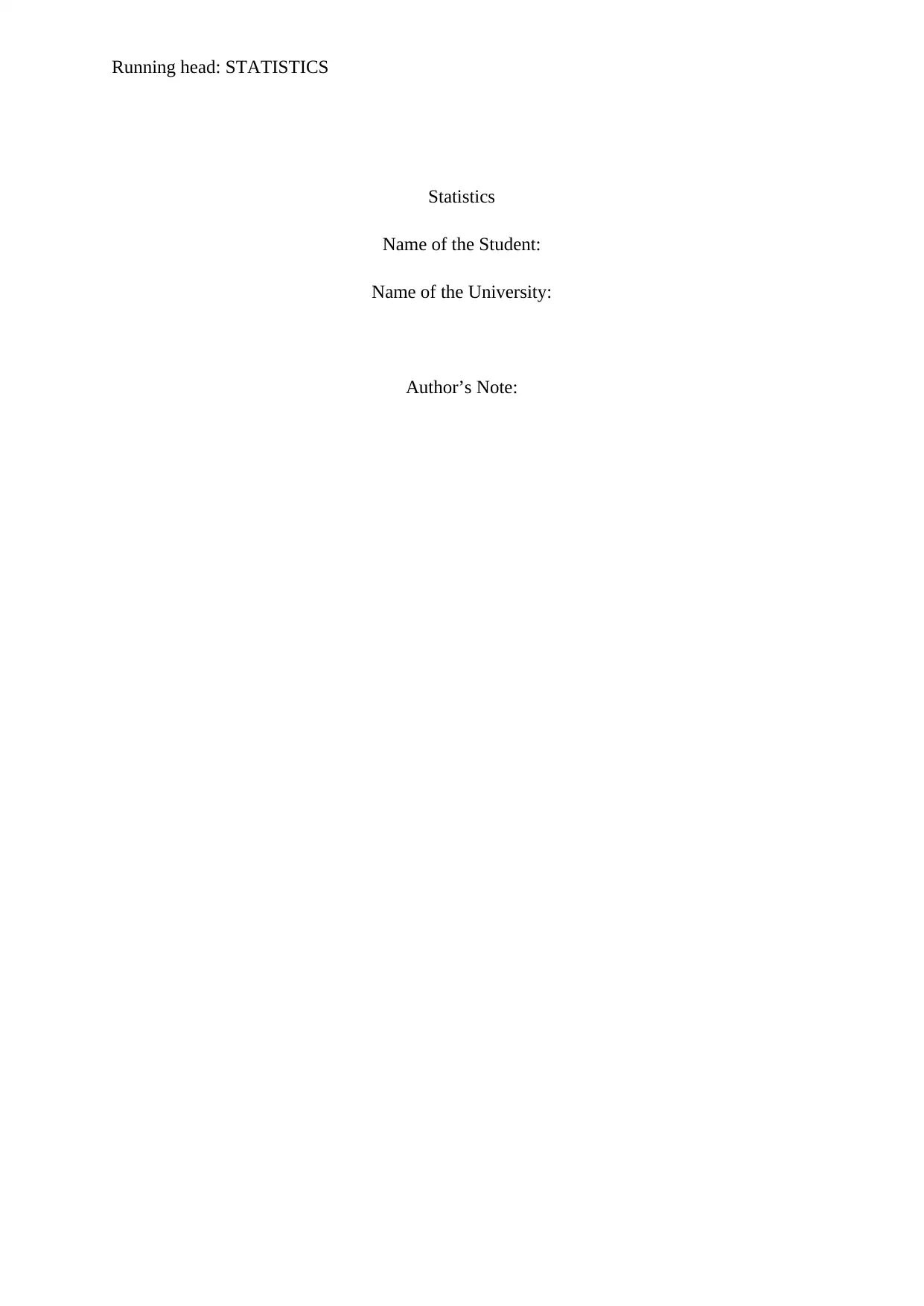
Running head: STATISTICS
Statistics
Name of the Student:
Name of the University:
Author’s Note:
Statistics
Name of the Student:
Name of the University:
Author’s Note:
Paraphrase This Document
Need a fresh take? Get an instant paraphrase of this document with our AI Paraphraser

1STATISTICS
Table of Contents
Answer 1....................................................................................................................................3
Answer 2....................................................................................................................................3
Answer 3....................................................................................................................................3
Answer 4....................................................................................................................................4
Answer 5....................................................................................................................................4
References:.................................................................................................................................5
Appendix:...................................................................................................................................6
Table of Contents
Answer 1....................................................................................................................................3
Answer 2....................................................................................................................................3
Answer 3....................................................................................................................................3
Answer 4....................................................................................................................................4
Answer 5....................................................................................................................................4
References:.................................................................................................................................5
Appendix:...................................................................................................................................6
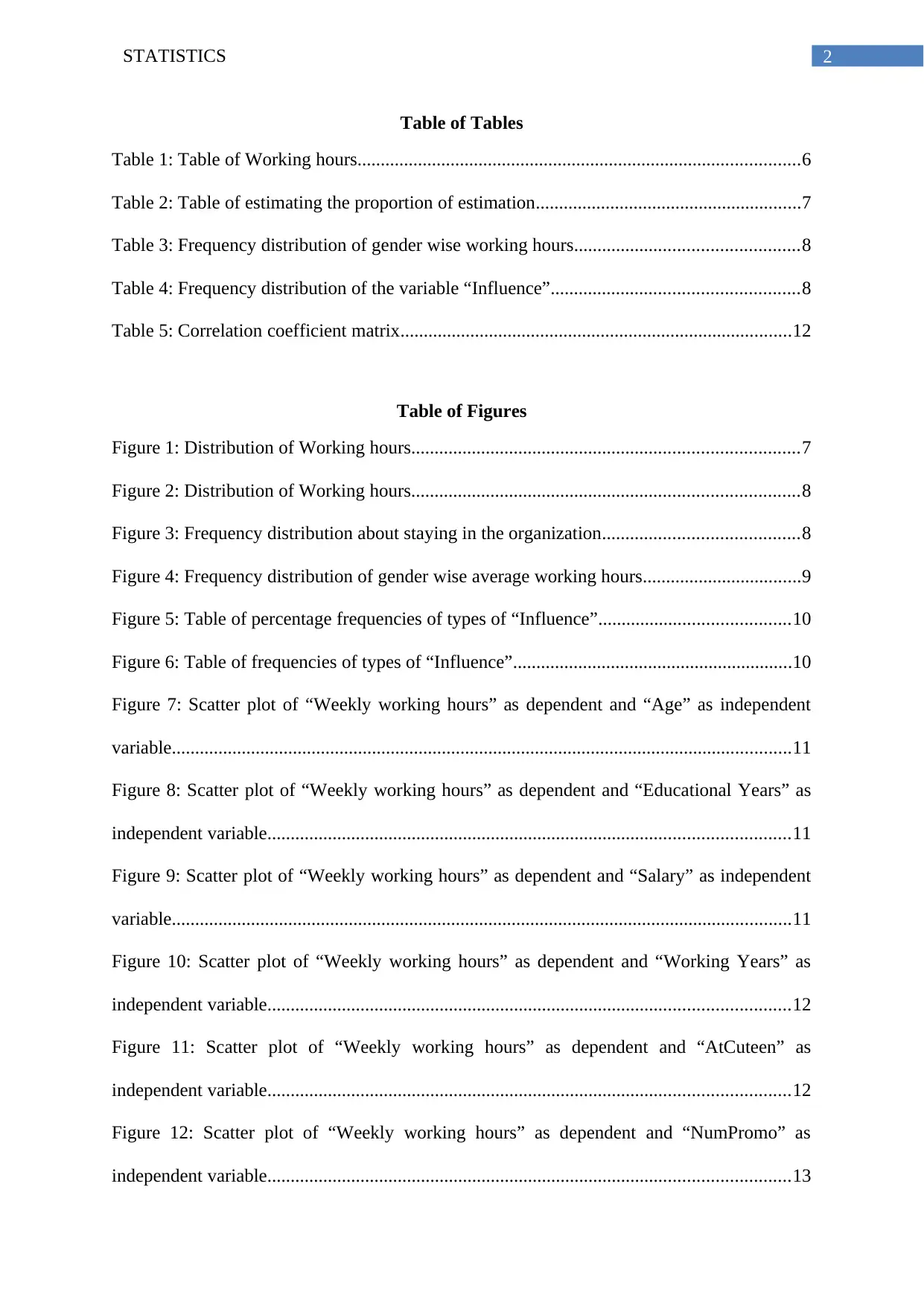
2STATISTICS
Table of Tables
Table 1: Table of Working hours...............................................................................................6
Table 2: Table of estimating the proportion of estimation.........................................................7
Table 3: Frequency distribution of gender wise working hours................................................8
Table 4: Frequency distribution of the variable “Influence”.....................................................8
Table 5: Correlation coefficient matrix....................................................................................12
Table of Figures
Figure 1: Distribution of Working hours...................................................................................7
Figure 2: Distribution of Working hours...................................................................................8
Figure 3: Frequency distribution about staying in the organization..........................................8
Figure 4: Frequency distribution of gender wise average working hours..................................9
Figure 5: Table of percentage frequencies of types of “Influence”.........................................10
Figure 6: Table of frequencies of types of “Influence”............................................................10
Figure 7: Scatter plot of “Weekly working hours” as dependent and “Age” as independent
variable.....................................................................................................................................11
Figure 8: Scatter plot of “Weekly working hours” as dependent and “Educational Years” as
independent variable................................................................................................................11
Figure 9: Scatter plot of “Weekly working hours” as dependent and “Salary” as independent
variable.....................................................................................................................................11
Figure 10: Scatter plot of “Weekly working hours” as dependent and “Working Years” as
independent variable................................................................................................................12
Figure 11: Scatter plot of “Weekly working hours” as dependent and “AtCuteen” as
independent variable................................................................................................................12
Figure 12: Scatter plot of “Weekly working hours” as dependent and “NumPromo” as
independent variable................................................................................................................13
Table of Tables
Table 1: Table of Working hours...............................................................................................6
Table 2: Table of estimating the proportion of estimation.........................................................7
Table 3: Frequency distribution of gender wise working hours................................................8
Table 4: Frequency distribution of the variable “Influence”.....................................................8
Table 5: Correlation coefficient matrix....................................................................................12
Table of Figures
Figure 1: Distribution of Working hours...................................................................................7
Figure 2: Distribution of Working hours...................................................................................8
Figure 3: Frequency distribution about staying in the organization..........................................8
Figure 4: Frequency distribution of gender wise average working hours..................................9
Figure 5: Table of percentage frequencies of types of “Influence”.........................................10
Figure 6: Table of frequencies of types of “Influence”............................................................10
Figure 7: Scatter plot of “Weekly working hours” as dependent and “Age” as independent
variable.....................................................................................................................................11
Figure 8: Scatter plot of “Weekly working hours” as dependent and “Educational Years” as
independent variable................................................................................................................11
Figure 9: Scatter plot of “Weekly working hours” as dependent and “Salary” as independent
variable.....................................................................................................................................11
Figure 10: Scatter plot of “Weekly working hours” as dependent and “Working Years” as
independent variable................................................................................................................12
Figure 11: Scatter plot of “Weekly working hours” as dependent and “AtCuteen” as
independent variable................................................................................................................12
Figure 12: Scatter plot of “Weekly working hours” as dependent and “NumPromo” as
independent variable................................................................................................................13
⊘ This is a preview!⊘
Do you want full access?
Subscribe today to unlock all pages.

Trusted by 1+ million students worldwide
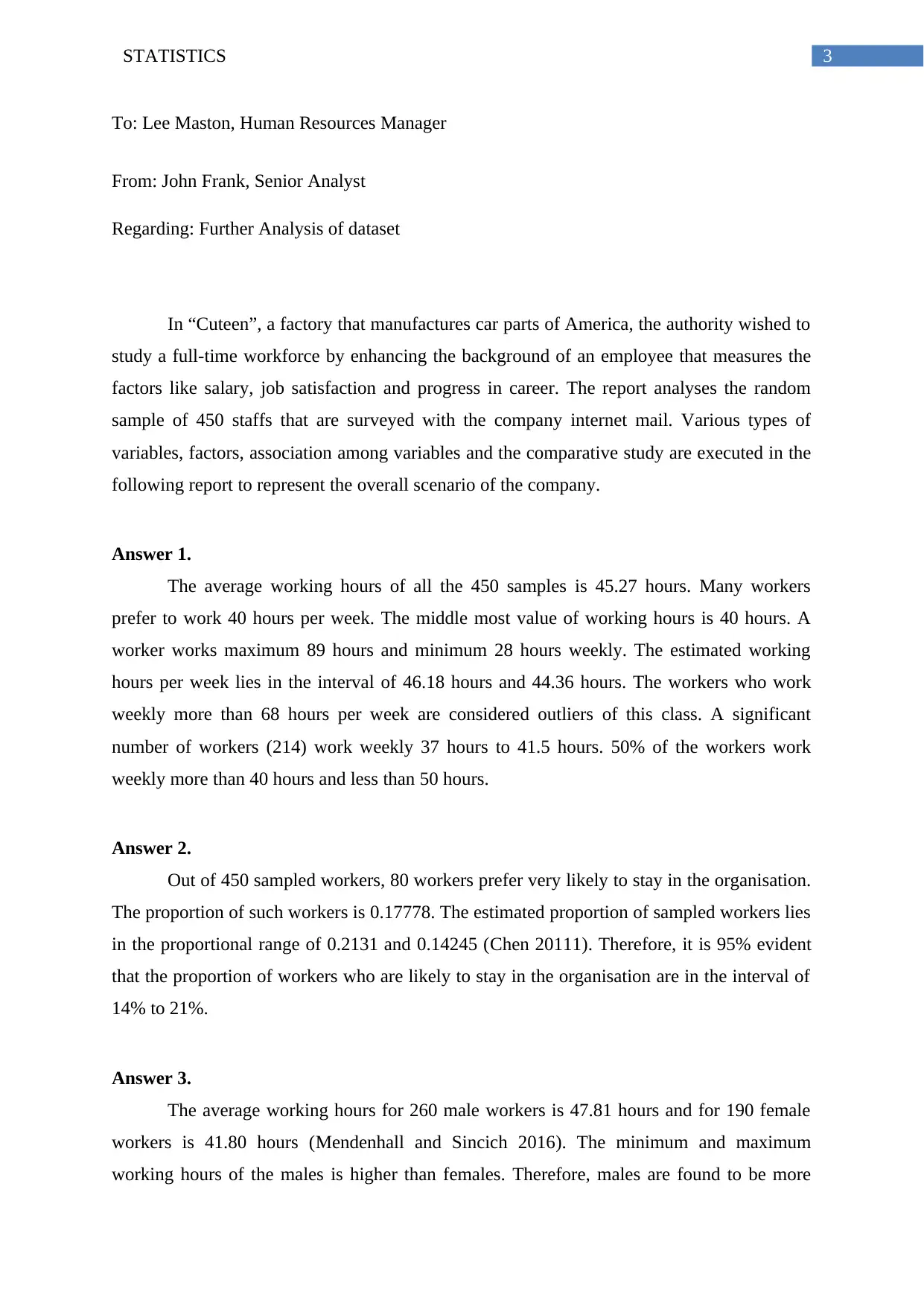
3STATISTICS
To: Lee Maston, Human Resources Manager
From: John Frank, Senior Analyst
Regarding: Further Analysis of dataset
In “Cuteen”, a factory that manufactures car parts of America, the authority wished to
study a full-time workforce by enhancing the background of an employee that measures the
factors like salary, job satisfaction and progress in career. The report analyses the random
sample of 450 staffs that are surveyed with the company internet mail. Various types of
variables, factors, association among variables and the comparative study are executed in the
following report to represent the overall scenario of the company.
Answer 1.
The average working hours of all the 450 samples is 45.27 hours. Many workers
prefer to work 40 hours per week. The middle most value of working hours is 40 hours. A
worker works maximum 89 hours and minimum 28 hours weekly. The estimated working
hours per week lies in the interval of 46.18 hours and 44.36 hours. The workers who work
weekly more than 68 hours per week are considered outliers of this class. A significant
number of workers (214) work weekly 37 hours to 41.5 hours. 50% of the workers work
weekly more than 40 hours and less than 50 hours.
Answer 2.
Out of 450 sampled workers, 80 workers prefer very likely to stay in the organisation.
The proportion of such workers is 0.17778. The estimated proportion of sampled workers lies
in the proportional range of 0.2131 and 0.14245 (Chen 20111). Therefore, it is 95% evident
that the proportion of workers who are likely to stay in the organisation are in the interval of
14% to 21%.
Answer 3.
The average working hours for 260 male workers is 47.81 hours and for 190 female
workers is 41.80 hours (Mendenhall and Sincich 2016). The minimum and maximum
working hours of the males is higher than females. Therefore, males are found to be more
To: Lee Maston, Human Resources Manager
From: John Frank, Senior Analyst
Regarding: Further Analysis of dataset
In “Cuteen”, a factory that manufactures car parts of America, the authority wished to
study a full-time workforce by enhancing the background of an employee that measures the
factors like salary, job satisfaction and progress in career. The report analyses the random
sample of 450 staffs that are surveyed with the company internet mail. Various types of
variables, factors, association among variables and the comparative study are executed in the
following report to represent the overall scenario of the company.
Answer 1.
The average working hours of all the 450 samples is 45.27 hours. Many workers
prefer to work 40 hours per week. The middle most value of working hours is 40 hours. A
worker works maximum 89 hours and minimum 28 hours weekly. The estimated working
hours per week lies in the interval of 46.18 hours and 44.36 hours. The workers who work
weekly more than 68 hours per week are considered outliers of this class. A significant
number of workers (214) work weekly 37 hours to 41.5 hours. 50% of the workers work
weekly more than 40 hours and less than 50 hours.
Answer 2.
Out of 450 sampled workers, 80 workers prefer very likely to stay in the organisation.
The proportion of such workers is 0.17778. The estimated proportion of sampled workers lies
in the proportional range of 0.2131 and 0.14245 (Chen 20111). Therefore, it is 95% evident
that the proportion of workers who are likely to stay in the organisation are in the interval of
14% to 21%.
Answer 3.
The average working hours for 260 male workers is 47.81 hours and for 190 female
workers is 41.80 hours (Mendenhall and Sincich 2016). The minimum and maximum
working hours of the males is higher than females. Therefore, males are found to be more
Paraphrase This Document
Need a fresh take? Get an instant paraphrase of this document with our AI Paraphraser
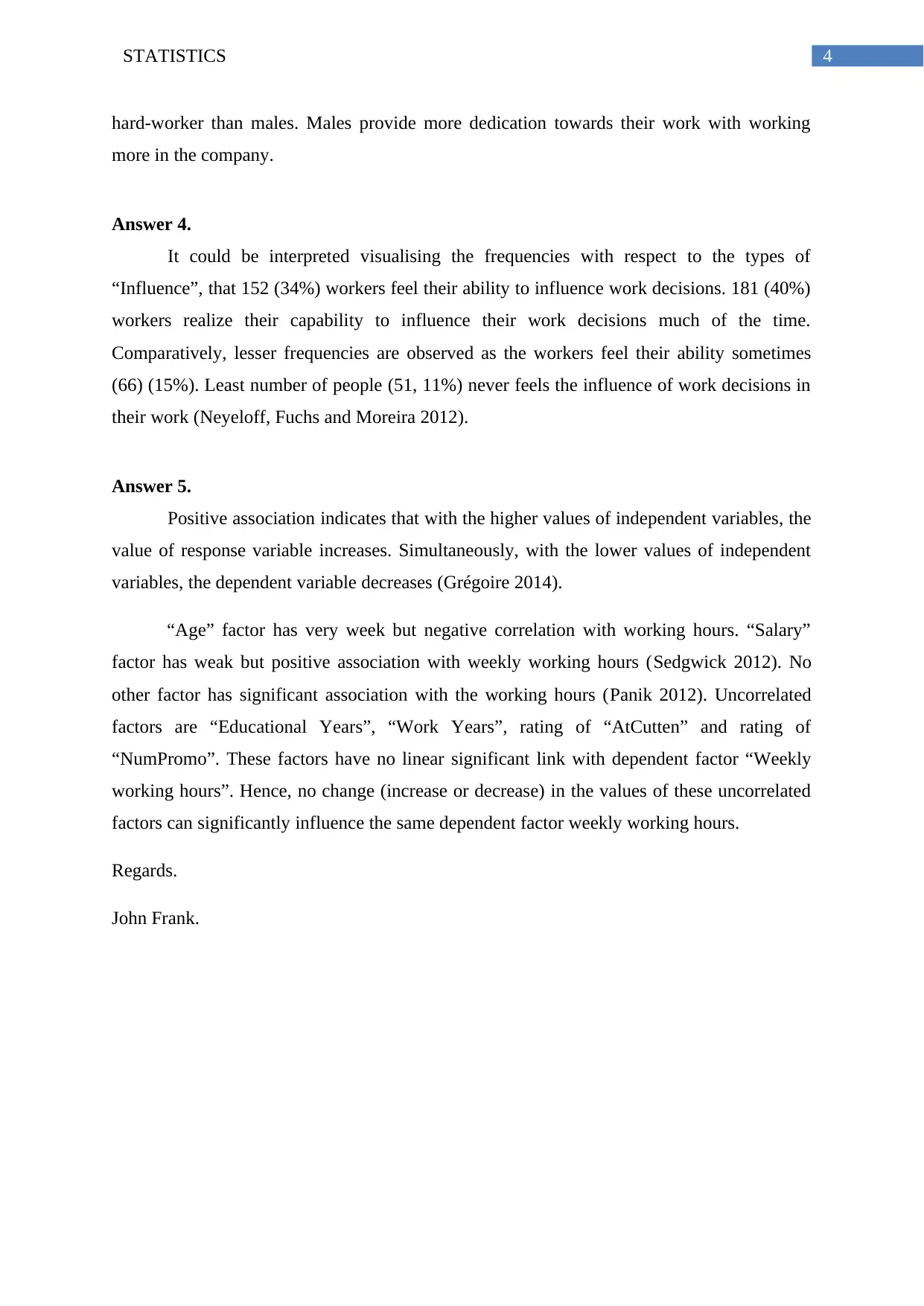
4STATISTICS
hard-worker than males. Males provide more dedication towards their work with working
more in the company.
Answer 4.
It could be interpreted visualising the frequencies with respect to the types of
“Influence”, that 152 (34%) workers feel their ability to influence work decisions. 181 (40%)
workers realize their capability to influence their work decisions much of the time.
Comparatively, lesser frequencies are observed as the workers feel their ability sometimes
(66) (15%). Least number of people (51, 11%) never feels the influence of work decisions in
their work (Neyeloff, Fuchs and Moreira 2012).
Answer 5.
Positive association indicates that with the higher values of independent variables, the
value of response variable increases. Simultaneously, with the lower values of independent
variables, the dependent variable decreases (Grégoire 2014).
“Age” factor has very week but negative correlation with working hours. “Salary”
factor has weak but positive association with weekly working hours (Sedgwick 2012). No
other factor has significant association with the working hours (Panik 2012). Uncorrelated
factors are “Educational Years”, “Work Years”, rating of “AtCutten” and rating of
“NumPromo”. These factors have no linear significant link with dependent factor “Weekly
working hours”. Hence, no change (increase or decrease) in the values of these uncorrelated
factors can significantly influence the same dependent factor weekly working hours.
Regards.
John Frank.
hard-worker than males. Males provide more dedication towards their work with working
more in the company.
Answer 4.
It could be interpreted visualising the frequencies with respect to the types of
“Influence”, that 152 (34%) workers feel their ability to influence work decisions. 181 (40%)
workers realize their capability to influence their work decisions much of the time.
Comparatively, lesser frequencies are observed as the workers feel their ability sometimes
(66) (15%). Least number of people (51, 11%) never feels the influence of work decisions in
their work (Neyeloff, Fuchs and Moreira 2012).
Answer 5.
Positive association indicates that with the higher values of independent variables, the
value of response variable increases. Simultaneously, with the lower values of independent
variables, the dependent variable decreases (Grégoire 2014).
“Age” factor has very week but negative correlation with working hours. “Salary”
factor has weak but positive association with weekly working hours (Sedgwick 2012). No
other factor has significant association with the working hours (Panik 2012). Uncorrelated
factors are “Educational Years”, “Work Years”, rating of “AtCutten” and rating of
“NumPromo”. These factors have no linear significant link with dependent factor “Weekly
working hours”. Hence, no change (increase or decrease) in the values of these uncorrelated
factors can significantly influence the same dependent factor weekly working hours.
Regards.
John Frank.
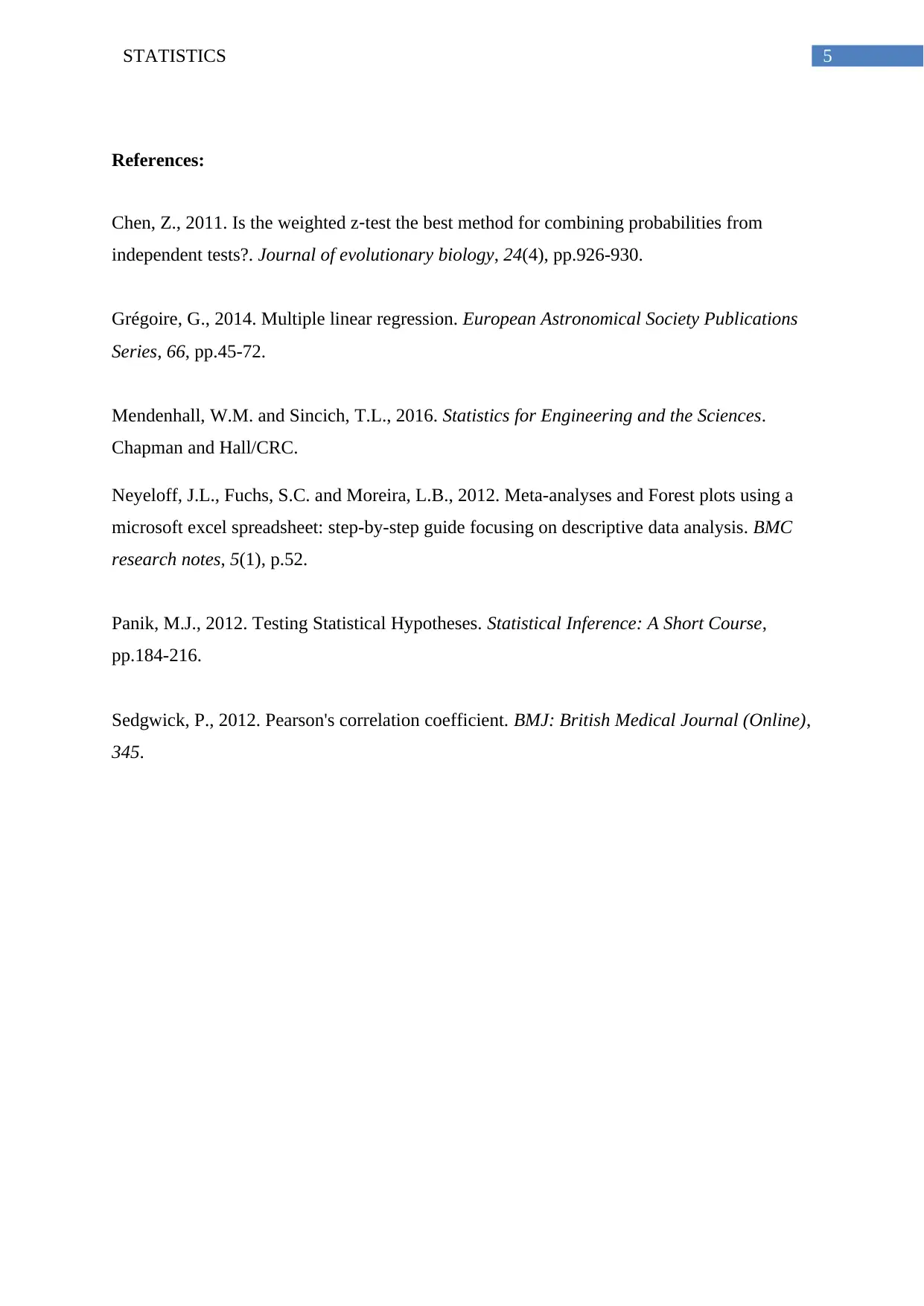
5STATISTICS
References:
Chen, Z., 2011. Is the weighted z‐test the best method for combining probabilities from
independent tests?. Journal of evolutionary biology, 24(4), pp.926-930.
Grégoire, G., 2014. Multiple linear regression. European Astronomical Society Publications
Series, 66, pp.45-72.
Mendenhall, W.M. and Sincich, T.L., 2016. Statistics for Engineering and the Sciences.
Chapman and Hall/CRC.
Neyeloff, J.L., Fuchs, S.C. and Moreira, L.B., 2012. Meta-analyses and Forest plots using a
microsoft excel spreadsheet: step-by-step guide focusing on descriptive data analysis. BMC
research notes, 5(1), p.52.
Panik, M.J., 2012. Testing Statistical Hypotheses. Statistical Inference: A Short Course,
pp.184-216.
Sedgwick, P., 2012. Pearson's correlation coefficient. BMJ: British Medical Journal (Online),
345.
References:
Chen, Z., 2011. Is the weighted z‐test the best method for combining probabilities from
independent tests?. Journal of evolutionary biology, 24(4), pp.926-930.
Grégoire, G., 2014. Multiple linear regression. European Astronomical Society Publications
Series, 66, pp.45-72.
Mendenhall, W.M. and Sincich, T.L., 2016. Statistics for Engineering and the Sciences.
Chapman and Hall/CRC.
Neyeloff, J.L., Fuchs, S.C. and Moreira, L.B., 2012. Meta-analyses and Forest plots using a
microsoft excel spreadsheet: step-by-step guide focusing on descriptive data analysis. BMC
research notes, 5(1), p.52.
Panik, M.J., 2012. Testing Statistical Hypotheses. Statistical Inference: A Short Course,
pp.184-216.
Sedgwick, P., 2012. Pearson's correlation coefficient. BMJ: British Medical Journal (Online),
345.
⊘ This is a preview!⊘
Do you want full access?
Subscribe today to unlock all pages.

Trusted by 1+ million students worldwide
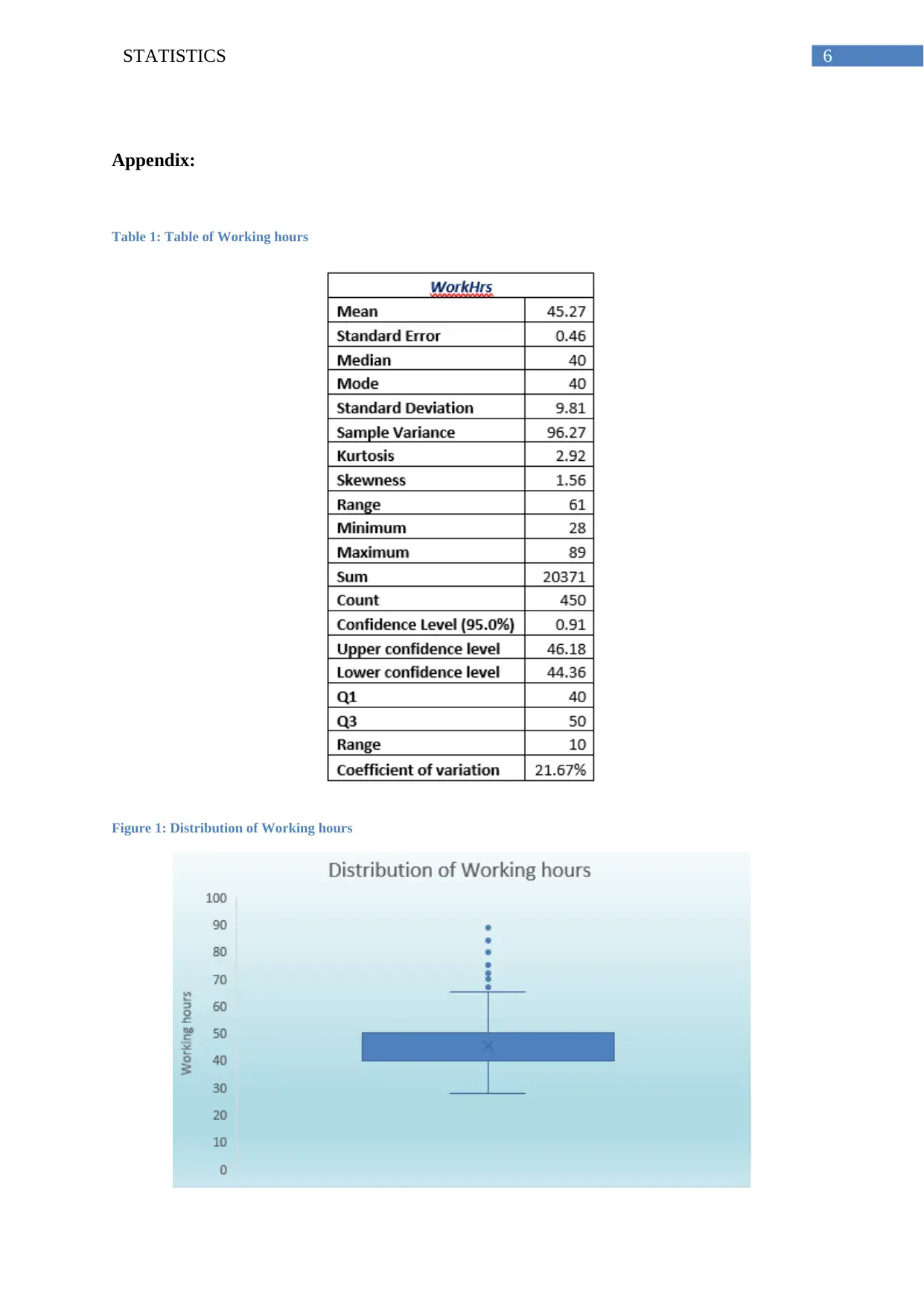
6STATISTICS
Appendix:
Table 1: Table of Working hours
Figure 1: Distribution of Working hours
Appendix:
Table 1: Table of Working hours
Figure 1: Distribution of Working hours
Paraphrase This Document
Need a fresh take? Get an instant paraphrase of this document with our AI Paraphraser

7STATISTICS
Figure 2: Distribution of Working hours
Table 2: Table of estimating the proportion of estimation
Figure 3: Frequency distribution about staying in the organization
Figure 2: Distribution of Working hours
Table 2: Table of estimating the proportion of estimation
Figure 3: Frequency distribution about staying in the organization
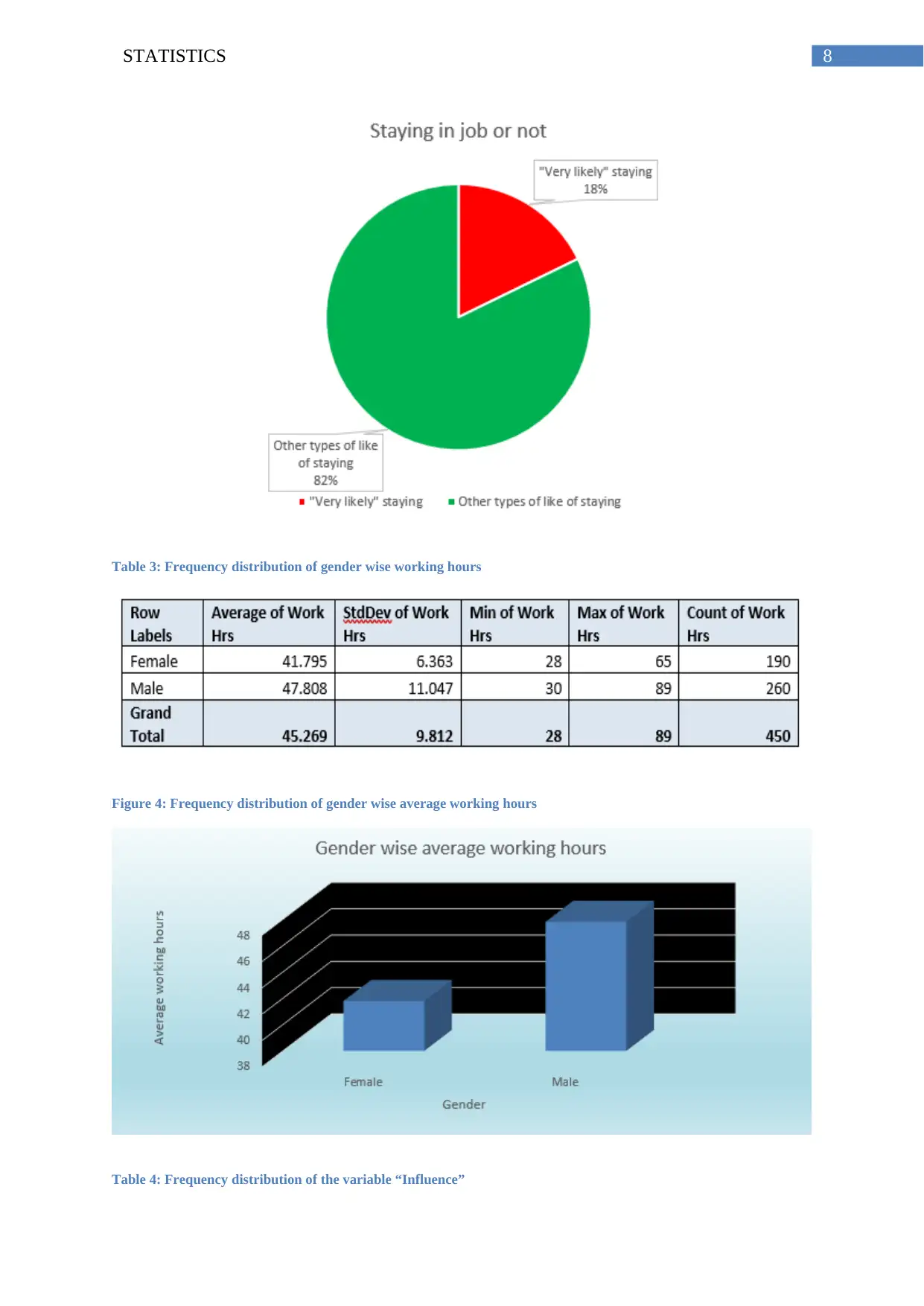
8STATISTICS
Table 3: Frequency distribution of gender wise working hours
Figure 4: Frequency distribution of gender wise average working hours
Table 4: Frequency distribution of the variable “Influence”
Table 3: Frequency distribution of gender wise working hours
Figure 4: Frequency distribution of gender wise average working hours
Table 4: Frequency distribution of the variable “Influence”
⊘ This is a preview!⊘
Do you want full access?
Subscribe today to unlock all pages.

Trusted by 1+ million students worldwide
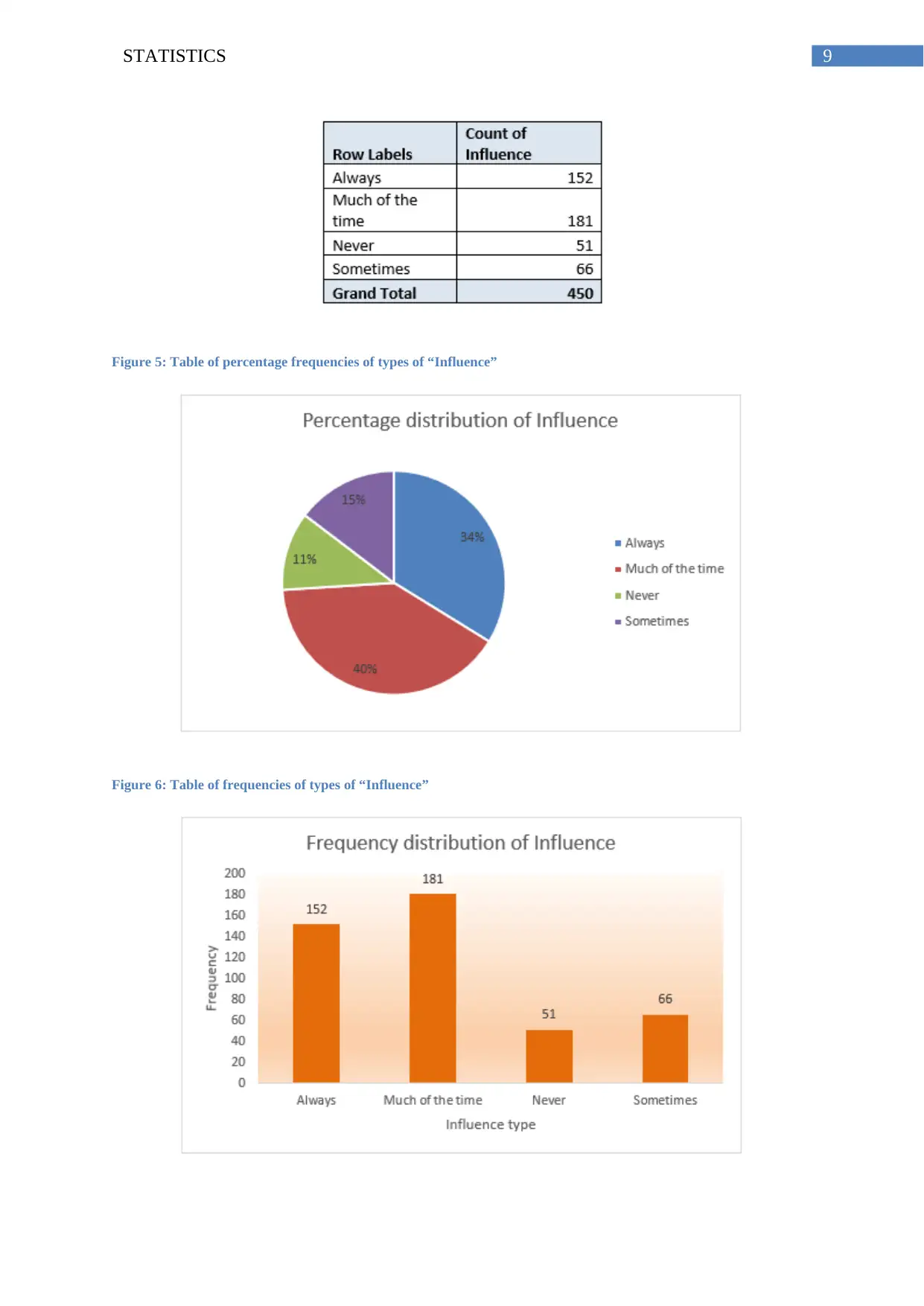
9STATISTICS
Figure 5: Table of percentage frequencies of types of “Influence”
Figure 6: Table of frequencies of types of “Influence”
Figure 5: Table of percentage frequencies of types of “Influence”
Figure 6: Table of frequencies of types of “Influence”
Paraphrase This Document
Need a fresh take? Get an instant paraphrase of this document with our AI Paraphraser
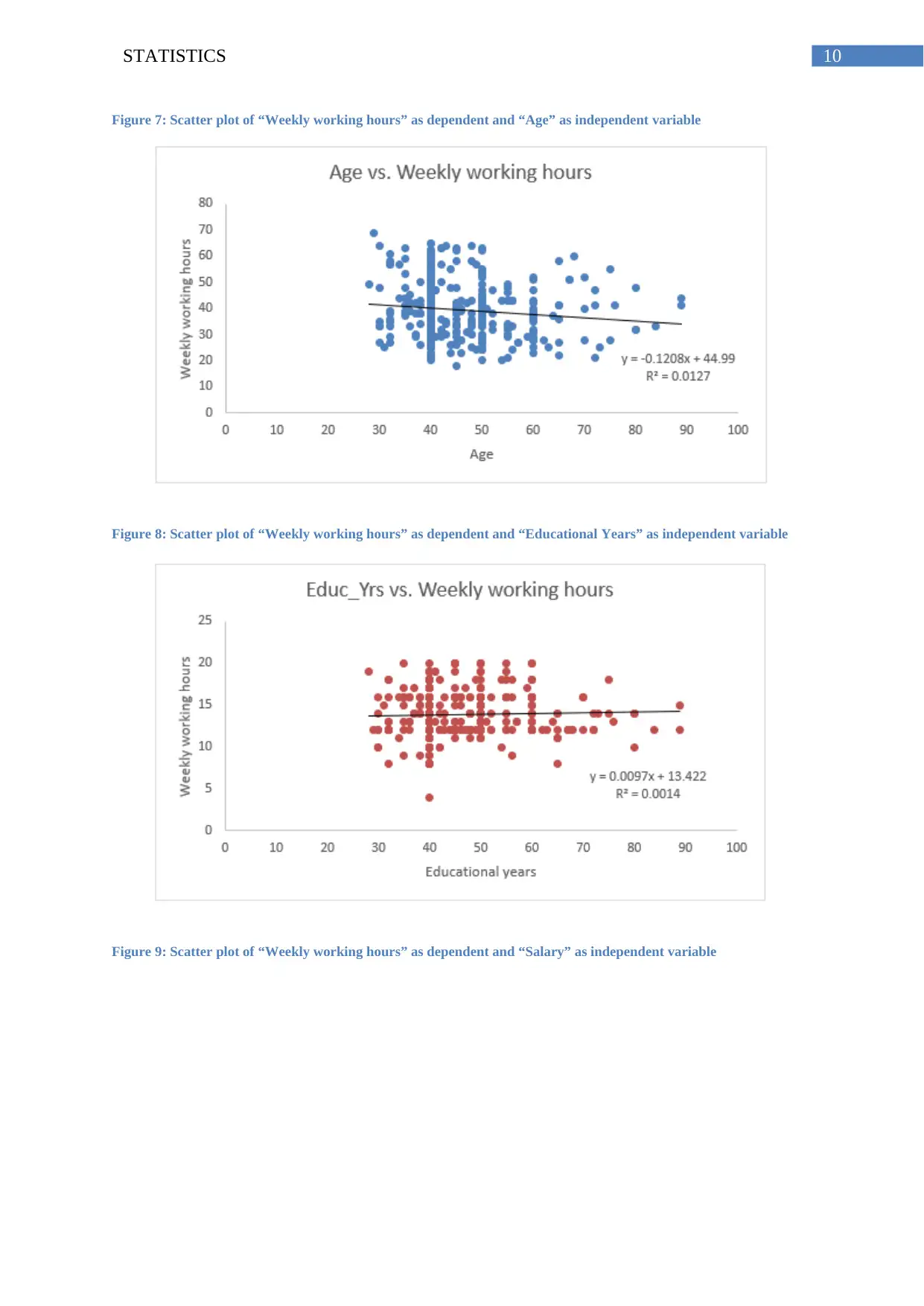
10STATISTICS
Figure 7: Scatter plot of “Weekly working hours” as dependent and “Age” as independent variable
Figure 8: Scatter plot of “Weekly working hours” as dependent and “Educational Years” as independent variable
Figure 9: Scatter plot of “Weekly working hours” as dependent and “Salary” as independent variable
Figure 7: Scatter plot of “Weekly working hours” as dependent and “Age” as independent variable
Figure 8: Scatter plot of “Weekly working hours” as dependent and “Educational Years” as independent variable
Figure 9: Scatter plot of “Weekly working hours” as dependent and “Salary” as independent variable
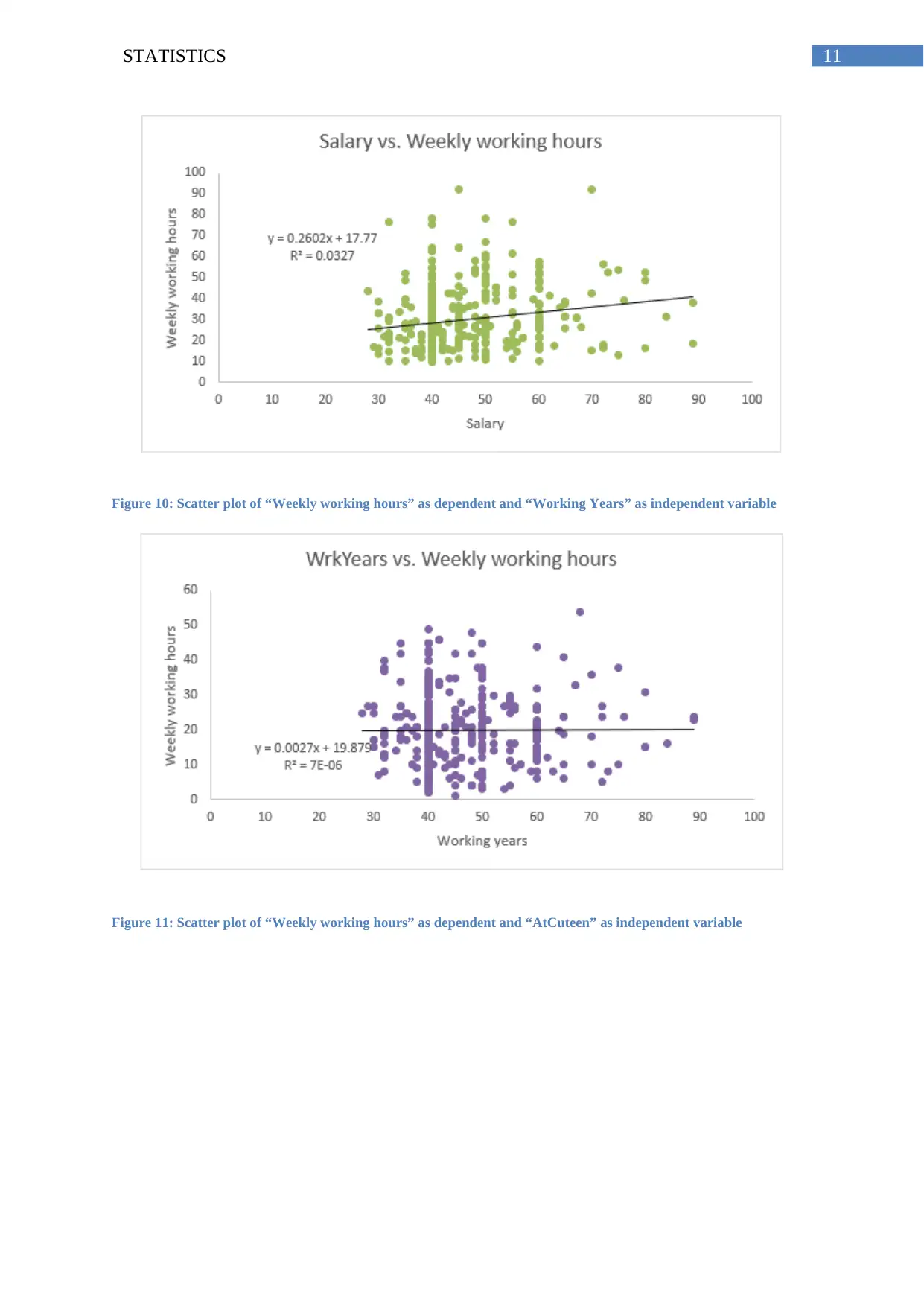
11STATISTICS
Figure 10: Scatter plot of “Weekly working hours” as dependent and “Working Years” as independent variable
Figure 11: Scatter plot of “Weekly working hours” as dependent and “AtCuteen” as independent variable
Figure 10: Scatter plot of “Weekly working hours” as dependent and “Working Years” as independent variable
Figure 11: Scatter plot of “Weekly working hours” as dependent and “AtCuteen” as independent variable
⊘ This is a preview!⊘
Do you want full access?
Subscribe today to unlock all pages.

Trusted by 1+ million students worldwide
1 out of 14
Related Documents
Your All-in-One AI-Powered Toolkit for Academic Success.
+13062052269
info@desklib.com
Available 24*7 on WhatsApp / Email
![[object Object]](/_next/static/media/star-bottom.7253800d.svg)
Unlock your academic potential
Copyright © 2020–2025 A2Z Services. All Rights Reserved. Developed and managed by ZUCOL.




